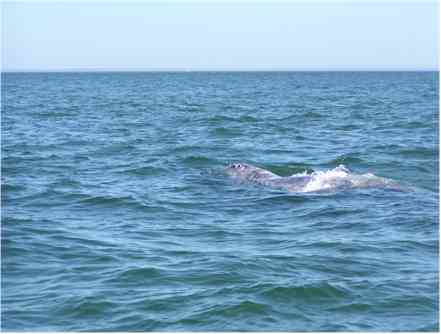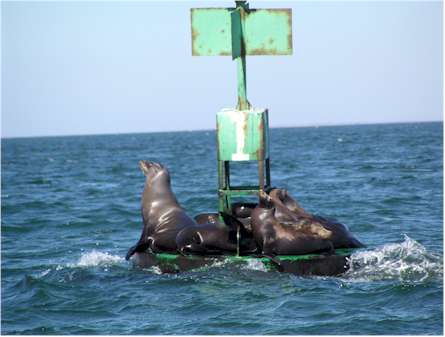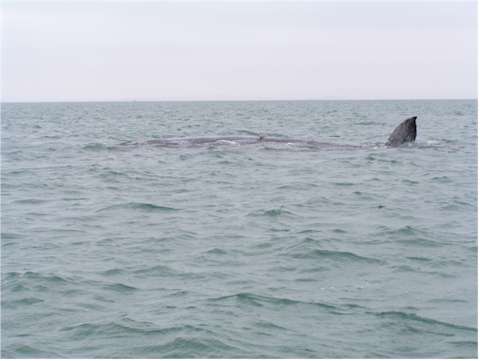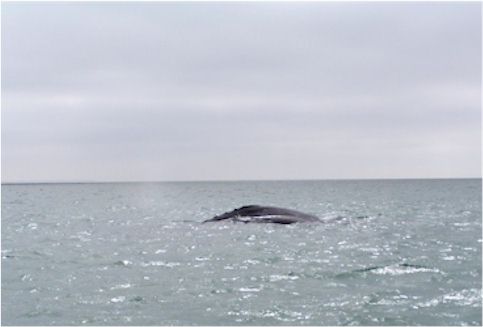Whale Watching in Baja
January 2006
There are three places in Baja California where the California
Gray Whales gather from January through March; Laguna Ojo de Liebre (Scammon's
Lagoon), Laguna de Saint Ignacio, and Magdalena Bay. These three places
are the end of a 3000 mile migration from the Bering Sea. All three areas
are protected both environmentally and legally. The areas are all small,
shallow, and have only narrow passes to the Pacific. These are necessary
characteristics for gray whale spawning grounds. The new-born whales
cannot swim and would drown in rough seas. the baby whales also need time
to grow the layer of fat needed to survive in the cold Arctic waters.
We visited two of the spawning grounds; Magdalena Bay (sometimes
called Mag Bay) and Scammon's Lagoon.
 The
Mag Bay trip was an adventure in itself. We camped in Ciudad Constitucion
and drove to San Carlos the next morning. When we got there, we saw a
small office advertising whale watching tours. We were told that we could
leave right away if we paid for the whole boat or we could wait awhile until
another couple arrived and split the cost. The wait was only about half an
hour and then we were ready to go. We followed the tour guide through town
toward the bay. On the way we stopped at a garage where they were working
on a boat; mounting and testing the outboaed motor. This took about
another half hour but now we were ready to go. We followed the guide on to
the bay where we got into another boat' not the one we waited to be set up.
But couldn't leave right away. It seems that another couple was on the way
and would arrive in a few minutes. The "few" minutes turned out to be
about thirty. Now we finally left but with a boat captain that spoke no
English. In three hours, we saw only this one whale.
The
Mag Bay trip was an adventure in itself. We camped in Ciudad Constitucion
and drove to San Carlos the next morning. When we got there, we saw a
small office advertising whale watching tours. We were told that we could
leave right away if we paid for the whole boat or we could wait awhile until
another couple arrived and split the cost. The wait was only about half an
hour and then we were ready to go. We followed the tour guide through town
toward the bay. On the way we stopped at a garage where they were working
on a boat; mounting and testing the outboaed motor. This took about
another half hour but now we were ready to go. We followed the guide on to
the bay where we got into another boat' not the one we waited to be set up.
But couldn't leave right away. It seems that another couple was on the way
and would arrive in a few minutes. The "few" minutes turned out to be
about thirty. Now we finally left but with a boat captain that spoke no
English. In three hours, we saw only this one whale.
The return trip was even more exciting. We ran out of gas
and had to borow some from another boat. Because of the delays, the tide
went out before we got back and the place we left from was now a quarter mile
wide mudflat. We were landed at another dock and had to be driven back to
our vehicles.
| Here is another picture of the whale shown above. We did get
fairly close. |
 |
 |
Whenever anyone found a whale, all the other nearby boats gathered
round. In case you hadn't noticed, even this very young whale is
much larger than the boats around her. Fortunately, the whale seem
to be very calm and not at all disturbed by all the activity around
them. |
| These seals found the perfect place for a little snooze in the sun.
Unfortunately, too many of them found this buoy at the same time.
While we were watching, another seal decided this was a good idea and
came aboard. When one more came on, one was pushed off the other
side and, once again, equilibrium was established. |
 |
 |
Our trip on Scammon's Lagoon was much more of a positive adventure.
The tour office is next door to the campground. They picked us up
there on time and took us to the boat. The boat was ready to leave
as soon as we got on board. It didn't run out of gas and returned
us to the dock on time where the car was waiting to take us home. A
government report showed there was an estimated 800 whales in the lagoon
and I believe it. We saw whales everywhere we went; like this
momma whale. |
| Here is momma with her baby right alongside. |
 |
The whales remain in Baja until sometime in April and then begin the 3000
mile trek home. The whole cycle is then repeated the following October.
I am very glad we took the tour; at least, I'm glad we took the second one.
It is fascinating to see animals so large and up so close. But I probably
won't do it again. The boat trip is not a comfortable one. It is
very cold on the water and even a slight swell makes for a rough ride when those
small boats (called pangas) speed up to about 10 knots.
 The
Mag Bay trip was an adventure in itself. We camped in Ciudad Constitucion
and drove to San Carlos the next morning. When we got there, we saw a
small office advertising whale watching tours. We were told that we could
leave right away if we paid for the whole boat or we could wait awhile until
another couple arrived and split the cost. The wait was only about half an
hour and then we were ready to go. We followed the tour guide through town
toward the bay. On the way we stopped at a garage where they were working
on a boat; mounting and testing the outboaed motor. This took about
another half hour but now we were ready to go. We followed the guide on to
the bay where we got into another boat' not the one we waited to be set up.
But couldn't leave right away. It seems that another couple was on the way
and would arrive in a few minutes. The "few" minutes turned out to be
about thirty. Now we finally left but with a boat captain that spoke no
English. In three hours, we saw only this one whale.
The
Mag Bay trip was an adventure in itself. We camped in Ciudad Constitucion
and drove to San Carlos the next morning. When we got there, we saw a
small office advertising whale watching tours. We were told that we could
leave right away if we paid for the whole boat or we could wait awhile until
another couple arrived and split the cost. The wait was only about half an
hour and then we were ready to go. We followed the tour guide through town
toward the bay. On the way we stopped at a garage where they were working
on a boat; mounting and testing the outboaed motor. This took about
another half hour but now we were ready to go. We followed the guide on to
the bay where we got into another boat' not the one we waited to be set up.
But couldn't leave right away. It seems that another couple was on the way
and would arrive in a few minutes. The "few" minutes turned out to be
about thirty. Now we finally left but with a boat captain that spoke no
English. In three hours, we saw only this one whale. 



